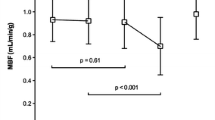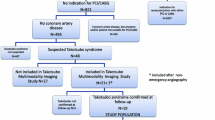Abstract
SPECT myocardial perfusion imaging (MPI) is commonly used for comprehensive interpretation of metabolic PET FDG imaging in ischemic dysfunctional myocardium. We evaluated the difference in scan interpretation introduced by CT attenuation correction (CTAC) of SPECT MPI in patients undergoing viability characterization by 99mTc SPECT MPI/PET FDG. In 46 consecutive patients (mean age 64, range 36–83 years) with dysfunctional myocardium, we analyzed viability from combined SPECT MPI and PET FDG scanning without attenuation correction (NC) and with CTAC for SPECT MPI. FDG uptake was classified in groups of percent uptake using the segment with maximum tracer in SPECT perfusion uptake as reference. Viability patterns were categorized as normal, mismatch, mild match and scar by relative comparison of SPECT and PET. Applying CTAC introduced a different reference segment for the normalization of PET FDG study in 57% of cases. As a result, the flow-metabolism pattern changed in 28% of segments, yielding a normal, mismatch, mild match and scar pattern in 462, 150, 123, and 47 segments with NC and 553, 86, 108, and 35 with CTAC, respectively (P = 0.001). Thus, by introducing CTAC for SPECT MPI 25% of segments originally classified as scar were reclassified and the number of normal segments increased by 20%. Introducing CTAC decreased by 54% the number of patients with possible indication for revascularization, from 26/46 to 12/46 (P < 0.001). Different interpretation of myocardial viability can be observed when using CTAC instead of NC SPECT MPI as reference for PET FDG scans.



Similar content being viewed by others
References
Kaufmann PA, Camici PG (2005) Myocardial blood flow measurement by pet: technical aspects and clinical applications. J Nucl Med 46(1):75–88
Kaufmann PA (2007) 82-rubidium—the dawn of cardiac pet in europe? Eur J Nucl Med Mol Imaging 34(12):1963–1964
Fricke E, Fricke H, Weise R, Kammeier A, Hagedorn R, Lotz N, Lindner O, Tschoepe D, Burchert W (2005) Attenuation correction of myocardial spect perfusion images with low-dose ct: evaluation of the method by comparison with perfusion pet. J Nucl Med 46(5):736–744
Masood Y, Liu YH, Depuey G, Taillefer R, Araujo LI, Allen S, Delbeke D, Anstett F, Peretz A, Zito MJ, Tsatkin V, Wackers FJ (2005) Clinical validation of spect attenuation correction using X-ray computed tomography-derived attenuation maps: multicenter clinical trial with angiographic correlation. J Nucl Cardiol 12(6):676–686
Schepis T, Gaemperli O, Koepfli P, Ruegg C, Burger C, Leschka S, Desbiolles L, Husmann L, Alkadhi H, Kaufmann PA (2007) Use of coronary calcium score scans from stand-alone multislice computed tomography for attenuation correction of myocardial perfusion spect. Eur J Nucl Med Mol Imaging 34(1):11–19
Gaemperli O, Schepis T, Valenta I, Koepfli P, Husmann L, Scheffel H, Leschka S, Eberli FR, Luscher TF, Alkadhi H, Kaufmann PA (2008) Functionally relevant coronary artery disease: comparison of 64-section ct angiography with myocardial perfusion spect. Radiology 248(2):414–423
Tillisch J, Brunken R, Marshall R, Schwaiger M, Mandelkern M, Phelps M, Schelbert H (1986) Reversibility of cardiac wall-motion abnormalities predicted by positron tomography. N Engl J Med 314(14):884–888
Koepfli P, Hany TF, Wyss CA, Namdar M, Burger C, Konstantinidis AV, Berthold T, Von Schulthess GK, Kaufmann PA (2004) Ct attenuation correction for myocardial perfusion quantification using a pet/ct hybrid scanner. J Nucl Med 45(4):537–542
Schepis T, Gaemperli O, Treyer V, Valenta I, Burger C, Koepfli P, Namdar M, Adachi I, Alkadhi H, Kaufmann PA (2007) Absolute quantification of myocardial blood flow with 13n-ammonia and 3-dimensional pet. J Nucl Med 48(11):1783–1789
Cerqueira MD, Weissman NJ, Dilsizian V, Jacobs AK, Kaul S, Laskey WK, Pennell DJ, Rumberger JA, Ryan T, Verani MS (2002) Standardized myocardial segmentation and nomenclature for tomographic imaging of the heart. A statement for healthcare professionals from the cardiac imaging committee of the council on clinical cardiology of the American heart association. Int J Cardiovasc Imaging 18(1):539–542
Hesse B, Tagil K, Cuocolo A, Anagnostopoulos C, Bardies M, Bax J, Bengel F, Busemann Sokole E, Davies G, Dondi M, Edenbrandt L, Franken P, Kjaer A, Knuuti J, Lassmann M, Ljungberg M, Marcassa C, Marie PY, McKiddie F, O’Connor M, Prvulovich E, Underwood R, van Eck-Smit B (2005) Eanm/esc procedural guidelines for myocardial perfusion imaging in nuclear cardiology. Eur J Nucl Med Mol Imaging 32(7):855–897
vom Dahl J, Altehoefer C, Sheehan FH, Buechin P, Schulz G, Schwarz ER, Koch KC, Uebis R, Messmer BJ, Buell U, Hanrath P (1997) Effect of myocardial viability assessed by technetium-99m-sestamibi spect and fluorine-18-fdg pet on clinical outcome in coronary artery disease. J Nucl Med 38(5):742–748
Schinkel AF, Poldermans D, Elhendy A, Bax JJ (2007) Assessment of myocardial viability in patients with heart failure. J Nucl Med 48(7):1135–1146
Rentrop KP, Cohen M, Blanke H, Phillips RA (1985) Changes in collateral channel filling immediately after controlled coronary artery occlusion by an angioplasty balloon in human subjects. J Am Coll Cardiol 5(3):587–592
Underwood SR, Bax JJ, vom Dahl J, Henein MY, Knuuti J, van Rossum AC, Schwarz ER, Vanoverschelde JL, van der Wall EE, Wijns W (2004) Imaging techniques for the assessment of myocardial hibernation. Report of a study group of the european society of cardiology. Eur Heart J 25(10):815–836
Beanlands RS, Nichol G, Huszti E, Humen D, Racine N, Freeman M, Gulenchyn KY, Garrard L, deKemp R, Guo A, Ruddy TD, Benard F, Lamy A, Iwanochko RM (2007) F-18-fluorodeoxyglucose positron emission tomography imaging-assisted management of patients with severe left ventricular dysfunction and suspected coronary disease: a randomized, controlled trial (parr-2). J Am Coll Cardiol 50(20):2002–2012
Iskandrian AS, Hakki AH, Kane SA, Goel IP, Mundth ED, Segal BL (1983) Rest and redistribution thallium-201 myocardial scintigraphy to predict improvement in left ventricular function after coronary arterial bypass grafting. Am J Cardiol 51(8):1312–1316
Galli M, Marcassa C, Imparato A, Campini R, Orrego PS, Giannuzzi P (1994) Effects of nitroglycerin by technetium-99m sestamibi tomoscintigraphy on resting regional myocardial hypoperfusion in stable patients with healed myocardial infarction. Am J Cardiol 74(9):843–848
Allman KC, Shaw LJ, Hachamovitch R, Udelson JE (2002) Myocardial viability testing and impact of revascularization on prognosis in patients with coronary artery disease and left ventricular dysfunction: a meta-analysis. J Am Coll Cardiol 39(7):1151–1158
Rizzello V, Poldermans D, Biagini E, Schinkel AF, Boersma E, Boccanelli A, Marwick T, Roelandt JR, Bax JJ (2009) Prognosis of patients with ischaemic cardiomyopathy after coronary revascularisation: relation to viability and improvement in left ventricular ejection fraction. Heart 95(15):1273–1277
Gerber BL, Ordoubadi FF, Wijns W, Vanoverschelde JL, Knuuti MJ, Janier M, Melon P, Blanksma PK, Bol A, Bax JJ, Melin JA, Camici PG (2001) Positron emission tomography using(18)f-fluoro-deoxyglucose and euglycaemic hyperinsulinaemic glucose clamp: optimal criteria for the prediction of recovery of post-ischaemic left ventricular dysfunction. Results from the European community concerted action multicenter study on use of(18)f-fluoro-deoxyglucose positron emission tomography for the detection of myocardial viability. Eur Heart J 22(18):1691–1701
Beanlands RS, Hendry PJ, Masters RG, deKemp RA, Woodend K, Ruddy TD (1998) Delay in revascularization is associated with increased mortality rate in patients with severe left ventricular dysfunction and viable myocardium on fluorine 18-fluorodeoxyglucose positron emission tomography imaging. Circulation 98(19(Suppl)):II51–II56
Hoefflinghaus T, Husmann L, Valenta I, Moonen C, Gaemperli O, Schepis T, Namdar M, Koepfli P, Siegrist PT, Kaufmann PA (2008) Role of attenuation correction to discriminate defects caused by left bundle branch block versus coronary stenosis in single photon emission computed tomography myocardial perfusion imaging. Clin Nucl Med 33(11):748–751
Fox K, Garcia MA, Ardissino D, Buszman P, Camici PG, Crea F, Daly C, De Backer G, Hjemdahl P, Lopez-Sendon J, Marco J, Morais J, Pepper J, Sechtem U, Simoons M, Thygesen K, Priori SG, Blanc JJ, Budaj A, Camm J, Dean V, Deckers J, Dickstein K, Lekakis J, McGregor K, Metra M, Osterspey A, Tamargo J, Zamorano JL (2006) Guidelines on the management of stable angina pectoris: executive summary: the task force on the management of stable angina pectoris of the European society of cardiology. Eur Heart J 27(11):1341–1381
Patel MR, Dehmer GJ, Hirshfeld JW, Smith PK, Spertus JA (2009) Accf/scai/sts/aats/aha/asnc 2009 appropriateness criteria for coronary revascularization: a report by the american college of cardiology foundation appropriateness criteria task force, society for cardiovascular angiography and interventions, society of thoracic surgeons, american association for thoracic surgery, american heart association, and the american society of nuclear cardiology endorsed by the american society of echocardiography, the heart failure society of America, and the society of cardiovascular computed tomography. J Am Coll Cardiol 53(6):530–553
Baker DW, Jones R, Hodges J, Massie BM, Konstam MA, Rose EA (1994) Management of heart failure: III. The role of revascularization in the treatment of patients with moderate or severe left ventricular systolic dysfunction. JAMA 272(19):1528–1534
Chareonthaitawee P, Gersh BJ, Araoz PA, Gibbons RJ (2005) Revascularization in severe left ventricular dysfunction: the role of viability testing. J Am Coll Cardiol 46(4):567–574
Slart RH, Bax JJ, Sluiter WJ, van Veldhuisen DJ, Jager PL (2004) Added value of attenuation-corrected tc-99m tetrofosmin spect for the detection of myocardial viability: comparison with fdg spect. J Nucl Cardiol 11(6):689–696
Matsunari I, Boning G, Ziegler SI, Nekolla SG, Stollfuss JC, Kosa I, Ficaro EP, Schwaiger M (1998) Attenuation-corrected 99mtc-tetrofosmin single-photon emission computed tomography in the detection of viable myocardium: comparison with positron emission tomography using 18f-fluorodeoxyglucose. J Am Coll Cardiol 32(4):927–935
Author information
Authors and Affiliations
Corresponding author
Rights and permissions
About this article
Cite this article
Nkoulou, R., Pazhenkottil, A.P., Buechel, R.R. et al. Impact of CT attenuation correction on the viability pattern assessed by 99mTc-tetrofosmin SPECT/18F-FDG PET. Int J Cardiovasc Imaging 27, 913–921 (2011). https://doi.org/10.1007/s10554-010-9719-8
Received:
Accepted:
Published:
Issue Date:
DOI: https://doi.org/10.1007/s10554-010-9719-8




